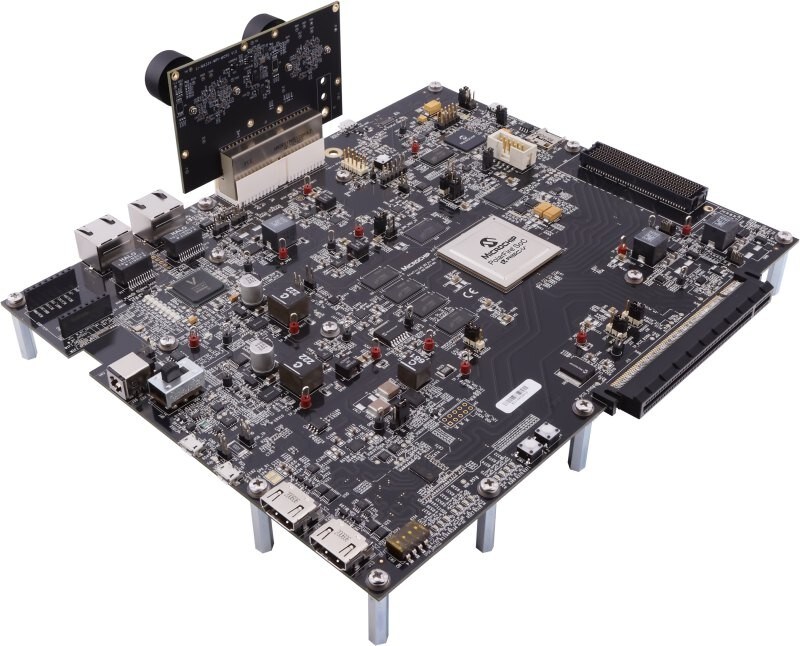We offer one of the widest automotive product portfolios for FPGAs and SoC FPGAs. Our customers use our low-power, instant-on and high-reliability AEC-Q100 FPGAs in many applications including inverter control and DC-DC conversion in electric/hybrid electric vehicles and Smart Embedded Vision (SEV) applications in various aspects of Advanced Driver-Assistance Systems (ADAS).
AEC-Q100 Qualification
Our FPGAs have a long heritage of supplying Grade 1 and Grade 2 automotive temperature parts with requisite PPAP and reliability documentation.
Up to 50% Lower Power
Our FPGAs consume up to 50% lower power compared to SRAM FPGAs, eliminating the need for active cooling.
Instant On
Our FPGAs use nonvolatile fabric that does not require reprogramming on boot up, making them suitable for applications that must be live at power up.
Small Form Factors
Our PolarFire® and PolarFire SoC FPGAs offer a unique combination of 12 Gbps SerDes, DDR4/LPDDR4 support and PCIe® Gen 2×4 in 11 × 11 mm/11 × 14.5 mm packages within 25K, 50K and 100K LUTs.
Long-Term Supply
We have a heritage of customer-driven obsolescence. Families launched as early as 1997 are still in production.
Functional Safety
Various high-reliability applications use our FPGAs. We offer IEC61508 SIL 3 functional safety packages for our ProASIC® 3, IGLOO®, SmartFusion® 2 and IGLOO® 2 families.
Explore Our FPGAs

PolarFire SoC

PolarFire FPGA

IGLOO 2 FPGA

SmartFusion 2 FPGA

ProASIC 3 FPGA

Electric Vehicle Inverters
You can use our low-density FPGAs, like our ProASIC 3 and IGLOO 2 FPGAs, for generating high-resolution PWM signals for DC-DC conversion and traction motor control. Our FPGAs offer instant-on capabilities, resilience against signal spikes and immunity against soft errors arising out of Single-Event Upsets (SEUs).

Advanced Driver-Assistance Systems (ADAS)
The low-power dissipation of PolarFire and PolarFire SoC FPGAs makes them suitable for thermal sensor-based collision avoidance cameras and LIDAR interface. These FPGAs contain 11 × 11 mm, small-form-factor packages with IOs capable of running MIPI-CSI2 Rx/Tx, 1G SGMII with IO CDR while supporting DDR4/LPDDR4.

E-Mirrors
The small footprint of E-Mirrors greatly enhances the aerodynamics of cars. With our FPGAs, the IRVM displays multiple E-Mirror displays via MIPI-CSI2 aggregation. PolarFire and PolarFire SoC FPGAs offer a great balance between small-form factor, low power consumption, communication and storage peripherals.

In-Cabin Monitoring
Our VectorBlox™ SDK for ML enables your in-cabin/driver monitoring CNNs to deploy in PolarFire FPGAs. ML that uses our VectorBlox SDK is 2–3× more efficient in terms of GOPs/W than SRAM-based FPGA solutions.

Head-Up Displays
PolarFire and PolarFire SoC FPGAs are a great choice for implementing windscreen-based head-up displays that require warping a flat video stream into a curved panel. FPGAs offer flexibility in choosing display protocols like HDMI®, DisplayPort™ or even MIPI® DSI-2.

Vehicle to Everything (V2X)
Early 5G deployments will use multi-rate USXGMII 1 to 10G Ethernet for antenna aggregation in small densities and form factors. Low-power and heat dissipation will be key as 5G antenna modules will be exposed to direct sunlight.

PolarFire SoC Video Kit
The PolarFire SoC Smart Embedded Vision (SEV) development platform is a full-featured RISC-V SoC FPGA kit that supports dual-4K MIPI CSI-2 cameras, HDMI 2.0 with FMC-based expansion towards CoaXPress 2.0, 6/12G SDI, 1/ 2.5/ 5/10G USXGMII and USB 3.1 Gen 1 and Gen 2 protocols. It also includes USB 2.0, SD™ card, eMMC, PCIe Gen 2×4 endpoint or root port and a mikroBUS™ connector that facilitates our Trust&GO platform for cloud connectivity.

PolarFire Video Kit
Evaluate 4K image processing and rendering using dual-camera sensors, numerous display interfaces and popular imaging and video protocols including MIPI CSI-2 TX, MIPI CSI-2 RX, HDMI 1.4 TX, HDMI2.0, DSI and HD/3G SDI.

CoaXPress® FMC Daughter Card
This FMC daughter card is a hardware evaluation platform for evaluating and testing the 12.5G CoaXPress protocol.

Serial Digital Interface (SDI) FMC Daughter Card
This daughter card is a hardware evaluation platform for evaluating and testing the SDI IP.

USXGMII FMC Daughter Card
Early 5G deployments will use multi-rate USXGMII 1 to 10G Ethernet for antenna aggregation in small densities and form factors. Low power and hence heat dissipation will be key as 5G antenna modules will be exposed to direct sunlight.

FPGA Webinars

Design Week
Watch the following FPGA-related sessions from Design Week:

